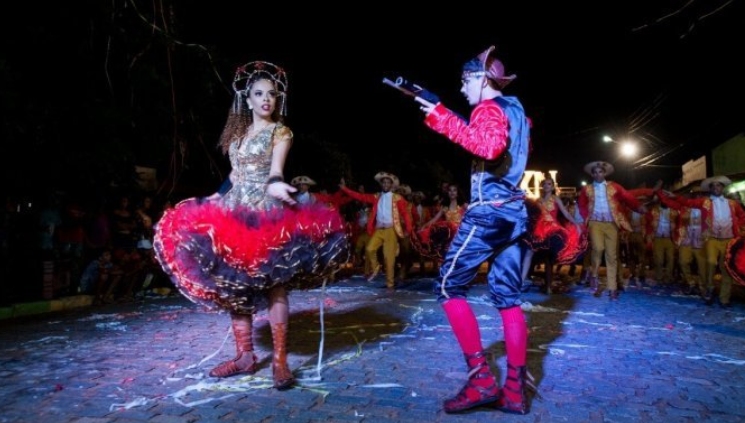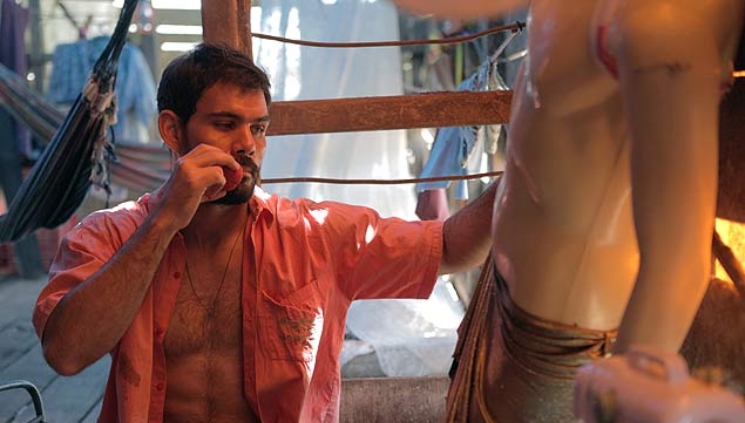Sertanidade and historical learning – Literature review | Sandra Maria dos Santos (SEC/Euclides da Cunha-BA)

Quadrilha Presentation in Euclides da Cunha [2021] | Image: Euclides da Cunha City Hall
Abstract: This review article analyzes popular sertanejo culture, focusing on June festivals and cordel literature in the Brazilian Northeast (2018-2022). It uses an interdisciplinary approach to explore the cultural identity, space and territorialities of the sertão, suggesting future research to better understand these elements in history education.
Keywords: Sertão, Sertanidade, Festa Junina, Cordel Literature.
Introduction
In this article, we review the specialized literature on identity elements of popular culture present in the northeastern hinterland that contribute to the process of affirming the sertanejo identity. Among these elements, we highlight June culture and cordel literature, seeking input to refine a research project that elucidates the following questions: What elements of the June festivities can be used as tools for teaching history, with the aim of reaffirming students’ sense of belonging to the Bahian hinterland? How can cordel literature enhance this approach in the classroom? This study is part of a master’s research project entitled The São João festival, sertanidade and cordel in History teaching as identity elements of belonging to the Euclid hinterland, developed within the scope of the Professional Master’s Degree in History Teaching (ProfHistória) postgraduate program at the Federal University of Sergipe – UFS/SE, during the 2023-2024 biennium.
The survey was carried out between August and October 2023, based on the works registered in the database of the CAPES Foundation’s Catalog of Theses and Dissertations, produced between 2018 and 2022, in the areas of human sciences, with an emphasis on History teaching. The choice of these works was guided by the presence of the following descriptors: “sertão”, “sertanidade”, “sertaneja identity”, “popular culture”, “festa junina”, “festa de São João”, “cultural identity” and “literatura de cordel”.
Results
In the course of the research, we identified 159 papers dealing with issues pertaining to the culture and identity of the sertanejo. Approximately 135 (85%) of these were dissertations, while the remaining 24 (15%) were doctoral theses. It is worth noting that these figures do not include all of the titles we prioritized for analysis. We emphasize that only 1/5 of this material covers two or more descriptors and is more in line with our research topic, which involves issues related to the sertaneja identity, Junina culture and cordel literature. For this reason, we chose to select only 12 texts for a full reading.
The percentage distribution of this survey reflects a significant emphasis on popular culture, making up 43% of the total. This segment includes, among other elements, June festivals and cordel literature, which are the centerpieces of our master’s research. In addition, considerable attention is paid to representations of the sertão, covering 14% of the scope of the research. The categories of identities and ethnic-racial relations share a similar percentage, each with 10%, indicating a balanced approach to the analysis of different cultural identities and their implications.
History teaching is covered in 9% of the texts, suggesting a concern to understand how these themes are incorporated into the educational environment. Education, with 6%, and public policies, with 4%, broaden the perspective to wider considerations about the social and governmental impact of these cultural elements. Only 1% of the titles are not directly aligned with the research proposals, highlighting a general cohesion in the scope of the study. This distribution suggests a comprehensive and balanced approach, integrating various aspects for a more complete understanding of the cultural phenomenon being examined.
When analyzing the titles surveyed, one can see a diversity of themes dealing with the sertão, ranging from cultural and literary issues to political and social aspects. The titles show a variety of themes, covering not only the physical geography of the sertão, but also its cultural, historical and social complexities. This reflects a comprehensive approach to understanding the region. The presence of titles that address literary, historical, anthropological and sociological themes highlights the interdisciplinary approach to analyzing the sertão. This is positive, as it allows for a deeper and richer understanding of the region. Many titles explore cultural identity and the relationship between people and the sertanejo territory. This emphasis can provide a meaningful understanding of how local communities perceive and construct their own identity.
Titles such as Os Sertões Naturais sobre as Lentes de Oswaldo Lamartine de Faria (1940-1980) (Araujo, 2022) suggest a visual approach, bringing an aesthetic dimension to the understanding of the sertão, which is beneficial for a more holistic appreciation of the region. Some titles focus on marginalized voices and perspectives, such as Vastas e Ermas: Mulheres Não Brancas no Sertão do Rio Grande (Seridó, séculos XVIII E XIX), (Santos, 2022), fundamental initiatives for a fairer and more inclusive representation of the diversity that exists in the sertão. Titles such as Capturing the hinterlands on the web: a look at the contemporary hinterlands disseminated/visualized in digital media (2018-2020), (Medeiros, 2022), indicate a focus on contemporaneity, exploring how the hinterland is represented and perceived in the digital age, adding a modern and relevant dimension to the research.
The presence of titles that address government programs, social movements and class issues reveals a consideration for the political and social dynamics that shape life in the sertão. The inclusion of titles that explore popular culture, such as SÁ (2021), Festa de São João Batista da Rua do Capim (Goiás, Go): audiovisual recording as a possibility to strengthen memory and identity in the place, as well as titles that deal with cordel literature and the indigenous voice, highlight the importance of considering different perspectives in understanding the sertão.
By immersing ourselves in this context, we are led to explore the intricate relationships between cultural identities, spatialities and territorialities, thus unveiling the sertão as a symbolic territory where the nuances of culture manifest themselves in a unique way. Popular culture thus reveals itself as a vibrant arena where individual and collective identities take shape and substance.
The title, The hinterland is neon: transversalities and pluralities of gender identities in Gabriel Mascaro’s film Boi Neon (Azevedo, 2022) provides a rich and contextualized analysis of the hinterland and its representations. The analysis of the film “Boi Neon” offers an opportunity to discuss how popular culture and the sertanejo identity are represented in contemporary cinema.
Juliano Cazarré in a scene from the movie ‘Boi Neon’ | Image: Folha de São Paulo
In Nem o mandacaru e nem o chapéu de couro: análises das multiterritorialidades das identidades culturais sertanejas no semiárido de Sergipe (Conceição, 2021), the title evokes the specific geography and culture of the Sergipe sertão. Highlighting the sertanejo identity, the title suggests an analysis rich in various categories that intertwine to address the complexity of the Brazilian sertão and its representations. By delving into spatialities, we realize that the physical and geographical territory is not just a passive setting, but an active player in the construction of identities. The relationship between people and the space they inhabit shapes and is shaped by their cultural practices. Spatialities become stages where identities unfold, highlighting the interdependence between communities and the places they occupy.
Overall, we can say that the diversity and depth of the titles provide a basis for an in-depth analysis of the northeastern hinterland, addressing not only its geographical features, but also its cultural and social complexities. This multifaceted approach is fundamental to a comprehensive understanding of this unique region.
Discussion
When examining the theses and dissertations in this research, it becomes clear that most of them focus on issues related to sertanejo identity, popular culture, especially the June festival, and cordel literature. On the one hand, their analysis reveals the diversity of approaches and gaps in the academic literature on image representations of the sertão and sertanejo cultural identity. On the other hand, it identifies some challenges in academic writing.
The results of the research provide important insights into the sertão, as exemplified in the approach Configuring Spaces and Subjects: the Sertão and the Sertanejo in the Writings of Ademar Vidal (1940-1950), which presents the construction of a cultural narrative about the sertanejo spatiality. For the author, Vidal does not limit himself to portraying a suffering sertão, but highlights a sertão of affections, of love for the place. He writes to preserve his best memories of life and prevent modernity from abruptly interfering with the sertanejos’ way of life (Marques, 2022, p.12).
In the case of the Feast of St. John the Baptist of Rua do Capim in Goiás, audiovisual recording emerges as a fundamental tool for preserving collective memory and strengthening the community’s cultural identity. Devotion to St. John the Baptist and the associated festivities show how faith, collectivity and belonging are intertwined, shaping the heritage of the place (Sá, 2021, p.173). Thus, the purpose of this study is to highlight the historical relevance of the social memory of the Rua do Capim community and the celebration in praise of St. John the Baptist. The text aims to promote the visibility of these elements, contributing to a broader understanding and appreciation of the rich cultural and religious tradition rooted in this community.
When exploring the territorialities of the June festival in Campina Grande (PB), the aforementioned research highlights how festival-goers demarcate, appropriate, perceive and experience the territory, generating what is known as the territorialities of the June festival (Marques, 2018, p.23). This suggests that the June festival doesn’t just take place in a specific location, but is actively shaped and experienced by the participants, influencing the construction of local identity.
In Rituals and folk communication – a symbolic communication system in São João do Maranhão (Almeida, 2018), the research reveals that rituals and folk communication play a crucial role in the construction of meaning and the expression of Maranhão’s identity. The analysis of ritualistic communication systems highlights the importance of these processes in the formation and preservation of cultural identity. Rituality therefore emerges as a form of communication capable of expressing diverse contents, highlighting the central role of identity in popular culture.
The use of cordel, as in the text Cordel Literature and History Teaching: Dialogues and Possibilities in Primary Education, shows promise, highlighting the proximity between cordel literature and popular discourses and cultures. The research indicates that this approach can encourage interdisciplinarity, creativity, the development of reading skills, orality and collective work, enriching the students’ repertoire (Costa, 2021, p.06). In this work, the territories explored are reformulated and overlapped, revealing the (re)configuration of senses and meanings, especially of the June festivities in various regions. The research also highlights the relevance of cordel pamphlets as a historical source for teaching history, providing a dialog with textbooks and historiography.
The research objectives are clearly delineated, covering analysis of discourses, identities, festivities, literary works and social practices in different regions of Brazil. The intersection between the areas of literature, popular culture, local history and education is evident, providing an interdisciplinary approach. In addition, the theoretical-methodological framework is robust, including references to various authors and concepts such as phenomenology, cultural identity, multi-territoriality, symbolic power, among others. The specific objectives are also clearly delineated, covering analysis in different geographical and thematic regions.
With regard to the contributions of these results to the development of our research, we observed that the studies on the configuration of spaces and subjects in the sertão, as expressed in the writings of Ademar Vidal (1940-1950), with the analyses on the multi-territorialities of sertanejo cultural identities in the semi-arid region of Sergipe, on the territorialities of the June festival in Campina Grande (PB), in the context of cordel literature and its role in the teaching of history, play a significant role in the theoretical foundation of our research.
Above all, these studies provide a conceptual framework that we intend to incorporate into our research. The use of Gadamer’s philosophical hermeneutics is one possibility, based on the concept of a hermeneutic circle, divided into commensality, clothing and spatiality (Almeida, 2018). Other contributions come in the form of concepts: Sertão (Arruda, 2000), Cultural Identity (Hall, 1996; Bauman, 2005), multi-territorialities (Haesbaer, 2004), Symbolic Power (Bourdieu,2010), Place in (Tuan, 2013), Popular Culture (Darnton, 1988; Burke, 2005; Certeau, 1982), Literature (Cândido, 1999; Sevcenko, 1999), History Teaching (Guimarães, 2003; Bittencourt, 2009) and Cordel Literature (Lima, 2010; Marinho, 2012). In addition, the aforementioned studies offer situations for using the categories Local History (PCN, 1997) and History Teaching (BNCC, 2018).
From a methodological point of view, research has adopted various procedures to obtain a comprehensive understanding of the subjects under investigation. A notable example is the use of oral history tools, with an emphasis on participant observation (Conceição, 2021), and digital ethnography/ethnography (Marques, 2018). Various collection and processing tools are highlighted, including interviews, field diaries, open dialogues and photographic/videographic records, adapting to the ways of constructing thought and the specific objectives of the research. Finally, the case study makes it possible to treat the empirical material obtained through interviews as part of a qualitative analysis. It helps to obtain a more detailed and contextualized view of the phenomena under study (Almeida, 2022).
In summary, the studies presented contribute to problematizing the categories of sertão and sertanejo, as well as a deeper understanding of sertanejo cultural practices, highlighting the nuances in Vidal’s approaches, festive dynamics, forms of ritualistic communication and the educational potential of cordel literature. These findings have significant implications for the preservation of cultural identity and the enrichment of history teaching, while at the same time broadening our view of the sertão, offering a valuable contribution to our research proposal.
The research also points out that using local history as a teaching tool gives students the opportunity to see themselves as historical subjects, thus contributing to the construction of part of their cultural identity. In the context of cordel literature, the analysis reveals that this form of expression has always been intrinsically linked to popular discourses and cultures. Its incorporation into history teaching is promising, providing benefits such as interdisciplinarity, creativity, developing reading skills, valuing orality and encouraging collective work.
Despite the valuable contributions we found in this survey, we identified some inefficient aspects, which we would like to avoid repeating in our research. Among the most damaging to the advancement of knowledge of the issues discussed here are: the lack of detailed methodology, including the selection of sources, methods of analysis and critical approaches, the absence of extrapolations – hypotheses that allow the generalization of the results for the entire semi-arid region of Sergipe and the lack of temporal representation, which can limit the understanding of transformations over time and underestimate the influence of these changes.
Conclusions
In the introduction, we outlined our aim of analyzing the relevance of the identity elements of popular culture, such as the June celebration and cordel literature, in the process of consolidating the sertanejo identity. Throughout this text, we seek to present arguments that support the thesis that literary production dedicated to the sertanidade is distinguished by its in-depth exploration of themes linked to popular culture. These themes are predominantly approached from the perspective of representations of the sertão, contributing to a broader and deeper understanding of the richness and complexity of this unique identity.
This review played a key role in guiding our decisions about the theoretical foundations and methodological scope involved in designing our research project. We are firmly convinced that the best approaches for exploring our central question – “What elements inherent to the June festivities can be used as tools for teaching history, with the aim of strengthening students’ sense of belonging to the Bahian hinterland, and how can cordel literature enhance this approach in the classroom?” – These questions involve alignment with representations of the sertão in the context of popular culture and sertanejo identity.
After this journey, it is with enthusiasm that we present the foundations of our research project. It will consist of a dissertation that aims to address the São João Festival, sertanidade and cordel in history teaching, considering them as fundamental identity elements to instill a sense of belonging to the Euclid sertão. Our mission is to understand and value the cultural traditions of this region, exploring the richness of the São João festival and the popular poetry of the cordel as essential components in the formation of local identity. The choice of this theme is justified by the perception that students lack a sense of belonging and identification with the sertanejo identity, inferring the June festivities as one of the identity-affirming elements of the sertaneidade, which can be enhanced in history teaching through the literary medium of the cordel.
Sources
ALMEIDA, Ana Quesia Souza de. A construção da identidade cultural do aluno a partir da história do município de Presidente Kennedy/ES. São Mateus, 2022. 103f. Dissertação (Mestrado Profissional em Ciência, Tecnologia e Educação) – Centro Universitário Vale do Cricaré.
ALMEIDA, Francinete Louseiro de. Rituais e Folkcomunicação – um sistema de comunicação simbólico no São João do Maranhão. Porto Alegre, 2018. 281 f. Tese (Doutorado em Comunicação Social) – Pontifícia Universidade Católica do Rio Grande do Sul.
ARAUJO, Natalia Raiane de Paiva. Os Sertões Naturais sobre as lentes de Oswaldo Lamartine de Faria (1940-1980). Caicó, 2022. 105 f. Dissertação (Mestrado em História) – Universidade Federal do Rio Grande Do Norte.
AZEVEDO, Gleice Linhares de. O sertão é neon: transversalidades e pluralidades de identidades de gêneros no filme boi neon de Gabriel Mascaro. Caicó, 2022. 156 f. Dissertação (Mestrado em História) – Universidade Federal Do Rio Grande do Norte.
CONCEICAO, Mirtes Rose Menezes da. Nem o mandacaru e nem o chapéu de couro: análises das multiterritorialidades das identidades culturais sertanejas no semiárido de Sergipe. Fortaleza, 2021.216 f. Tese (Doutorado em Geografia) – Universidade Estadual do Ceará.
COSTA, Ronie Franca. Literatura de cordel e ensino de História: diálogos e possibilidades no Ensino Fundamental. Guarulhos, 2021. 131 f. Dissertação (Mestrado Profissional em Ensino de História) – Universidade Federal de São Paulo.
MARQUES, Jordania Alyne Santos. As territorialidades da festa junina de Campina Grande (PB) (2016-2017). Natal, 2018. 116 f. Dissertação (Mestrado em Geografia) – Universidade Federal do Rio Grande do Norte.
MARQUES, Maria Joedna Rodrigues. Configurando Espaços e Sujeitos: o sertão e o sertanejo nos escritos de Ademar Vidal (1940-1950). Caicó, 2022. 109 f. Dissertação (Mestrado em História) – Universidade Federal do Rio Grande do Norte.
MEDEIROS, Franciely de Lucena. Captura dos sertões na rede: um olhar sobre os sertões contemporâneos divulgados/visualizados nas mídias digitais (2018- 2020). Caicó, 2022. 101 f. Dissertação (Mestrado em História) – Universidade Federal do Rio Grande do Norte.
MEDEIROS, Maria Alda Jana Dantas de. Vastas e ermas: mulheres não brancas no sertão do Rio Grande (Seridó, séculos XVIII E XIX). Caicó, 2022. 277 F. Dissertação (Mestrado em História) – Universidade Federal Do Rio Grande do Norte, Caicó, 2022.
SANTOS, Ary Leonan Lima. Utilização do cordel como ferramenta para o ensino de história: conceitos, repertórios e experiências. São Cristóvão, 2018.101 F. Dissertação (Mestrado Profissional em Ensino de História) – Universidade Federal de Sergipe, São Cristovão.
SA, Sinara Carvalho de. Festa de São João Batista da Rua do Capim (Goiás, Go): registro audiovisual como possibilidade de fortalecimento da memória e da identidade no lugar. Goiânia, 2021. 191 f. Dissertação (Mestrado Profissional em Estudos Culturais Memoria e Patrimônio) – Universidade Estadual de Goiás.
References
ARRUDA, Gilmar. Cidades e sertões: entre a história e a memória. Bauru: EDUSC, 2000.
BARROS, José D’Assunção. Os conceitos. Seus usos nas Ciências Humanas. Petrópolis: 2016.
BARROS, José D’Assunção. O uso dos conceitos: Uma abordagem interdisciplinar. Petrópolis: Vozes, 2021.
BAUMAN, Zygmunt. Identidade. Rio de Janeiro: Zahar, 2005.
BAUMAN, Zygmunt. Comunidade: a busca por segurança no mundo atual. 2ed. Rio de Janeiro: Zahar, 2022.
BITTENCOURT, Circe. Ensino de História: fundamentos e métodos. 3ed. São Paulo: Cortez, 2009.
BRASIL. Ministério da Educação. Base Nacional Comum Curricular. Brasília: SEB/MEC, 2018.
BOURDIEU, Pierre. O Poder Simbólico. 13ed. Tradução de Fernando Tomaz. Rio de Janeiro: Bertrand Brasil, 2010.
BOSI, Ecléa. Memória e sociedade: lembranças de velhos. São Paulo: Companhia das Letras, 1994.
BURKE, Peter. O que é História Cultural? Rio de Janeiro: Zahar, 2005.
CÂNDIDO, Antônio. “O direito à Literatura”. In: Vários escritos. São Paulo: Duas Cidades, 1999.
CERTEAU, Michel de. A Escrita da História. Rio de Janeiro: Forense-Universitária, 1982.
DARNTON, R. O grande massacre de gatos: e outros episódios da história cultural francesa. 2ed. Rio de Janeiro: Graal, 1988.
FREITAS, Itamar. Orientações para a escrita de um artigo simplificado de revisão da literatura com o auxílio de Inteligência Artificial. Resenha Crítica. Aracaju/Crato, 12 maio, 2023. Disponível em <https://www.resenhacritica.com.br/a-cursos/orientacoes-para-a-escrita-de-um-artigo-simplificado-de-revisao-da-literatura-com-o-auxiiio-da-inteligenci-artificial/>.
HALL, Stuart. Identidade cultural e diáspora. Revista do Patrimônio Histórico e Artístico Nacional. Rio de Janeiro, v.x, n.x, p. 68-75, 1996.
HAESBEAERT, Rogério. Definindo Território para Entender a Desterritorialização. In: O mito da desterritorialização. 13ed. São Paulo:Bertrand Brasil, 2004, p. 35-80.
HALBWACHS, Maurice. A Memória Coletiva. Tradução de Beatriz Sidou. 2ed. São Paulo: Centauro, 2013.
LIMA, Arievaldo Viana. Cordel: da feira à sala de aula. In: MENDONÇA, Rosa Helena (org.). Literatura de Cordel e Escola. Salto para o Futuro, Ano XX, boletim 16, outubro, 2010. p. 20-27.
MARINHO, Ana Cristina; PINHEIRO, Hélder. O cordel no cotidiano escolar. São Paulo: Cortez, 2012.
ROSA, João Guimarães. Grande Sertão Veredas. Nova Fronteira, 2006.
SANTOS, Milton. A Natureza do Espaço: Técnica e Tempo, Razão e Emoção. 4ed. São Paulo: EDUSP, 2006.
SEVCENKO, Nicolau. Literatura como missão: tensões sociais e criação cultural na Primeira República. 4. ed. São Paulo: Brasiliense, 1999.
TUAN, Yu‐Fu. Espaço e lugar. A perspectiva da experiência. Londrina: EDUEL, 2013.
Author
 Sandra Maria dos Santos is a master’s student in History (ProfHistória/UFS), CAPES Fellow, specialist in Afro-Brazilian History (FIJ), History graduate (CESVASF) and elementary school teacher (SEC/Euclides da Cunha-BA). LATTES ID: http://lattes.cnpq.br/4646320281558583; ORCID ID: https://orcid.org/0009-0007-4961-0482; E-mail: [email protected].
Sandra Maria dos Santos is a master’s student in History (ProfHistória/UFS), CAPES Fellow, specialist in Afro-Brazilian History (FIJ), History graduate (CESVASF) and elementary school teacher (SEC/Euclides da Cunha-BA). LATTES ID: http://lattes.cnpq.br/4646320281558583; ORCID ID: https://orcid.org/0009-0007-4961-0482; E-mail: [email protected].
To cite this text
SANTOS, Sandra Maria. Sertanidade and historical learning – Literature review. Crítica Historiográfica. Natal, v.3, n.13, Sep/Oct, 2023. Available at <https://www.criticahistoriografica.com.br/en/sertanidade-and-historical-learning-literature-review-sandra-maria-dos-santos-sec-euclides-da-cunha-ba/>.
© – Authors who publish in Crítica Historiográfica agree to the distribution, remixing, adaptation and creation of their texts, even for commercial purposes, provided that they are given due credit for the original creations. (CC BY-SA).
Crítica Historiográfica. Natal, v.3, n. 13, Sep/Oct, 2023 | ISSN 2764-2666









